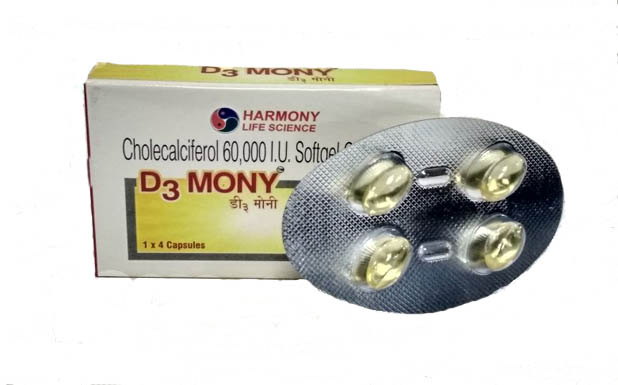Indications
Bone diseases in renal osteodystrophy,
Dietary supplement,
Bones weakening,
Better absorption,
Acidity & Heartburn,
Stomach ulcer,
Diarrhea,
Wilson's disease,
Acne,
Age related vision loss, and
Anemia.
Pharmacology
PHARMACODYNAMIC PROPERTIES OF CALCITRIOL
Calcitriol, a pharmaceutical form of vitamin D, has anti-osteoporotic, immunomodulatory, anticarcinogenic, antipsoriatic, antioxidant, and mood-modulatory activities. Calcitriol has been found to be effective in the treatment of psoriasis when applied topically. Calcitriol has been found to induce differentiation and/or inhibit cell proliferation in a number of malignant cell lines including human prostate cancer cells. Vitamin D deficiency has long been suspected to increase the susceptibility to tuberculosis. The active form of calcitriol, 1,25-(OH)2-D3, has been found to enhance the ability of mononuclear phagocytes to suppress the intracellular growth of Mycobacterium tuberculosis. 1,25-(OH)2-D3 has demonstrated beneficial effects in animal models of such autoimmune diseases as rheumatoid arthritis. It has also been found to induce monocyte differentiation and to inhibit lymphocyte proliferation and production of cytokines, including interleukin IL-1 and IL-2, as well as to suppress immunoglobulin secretion by B lymphocytes. Vitamin D appears to demonstrate both immune-enhancing and immunosuppressive effects.
PHARMACOKINETIC PROPERTIES OF CALCITRIOL
ABSORPTION:
Calcitriol is rapidly absorbed from the intestine. Peak serum concentrations following a single oral dose of 0.25-1µg Rocaltrol in healthy subjects were found within 2-6 hours.
DISTRIBUTION:
During transport in the blood at physiological concentrations, calcitriol is mostly bound to a specific vitamin D binding protein (DBP), but also, to a lesser degree, to lipoproteins and albumin.
METABOLISM:
Calcitriol is hydroxylated and oxidised in the kidney and in the liver by a specific cytochrome P450 enzyme: CYP24A1.
ELIMINATION:
The elimination half-life of calcitriol in plasma ranges between 5 to 8 hours.
PHARMACODYNAMIC PROPERTIES OF CALCIUM CARBONATE
Calcium is ne eded for so many different functions in the body, from bones, to blood clotting, your muscles etc. It is an essential mineral that provides strength to bones and teeth, but it has several other health benefits. Calcium is essential to nerve conduction, hormone status and muscle contraction. Some research has shown that diets rich in calcium, fruits and vegetables can reduce the risk of high blood. Calcium helps the body form bones and teeth and is required for blood clotting, transmitting signals in nerve cells, and muscle contraction. Calcium helps prevent osteoporosis; of the two to three pounds of calcium contained in the human body, 99% is located in the bones and teeth. Calcium reduces the risk of osteoporosis.
PHARMACODYNAMIC PROPERTIES OF ZINC
Zinc is a trace mineral and it is essential for many bodily functions including the immune response, reproduction, growth and development, and neurological roles. It is found in several systems and biological reactions, and it is needed for immune function, wound healing, blood clotting, and thyroid function. Zinc is not only important for enzymes but also for proteins and amino acid syntheses. It is involved in learning, memory formation, cellular signalling, gene expression and the metabolism of DNA and RNA. Zinc makes up a small percentage of the bone; zinc is needed to form hydroxylapatite which is a naturally occurring crystalline calcium complex. Hydroxylapatite crystals form the bulk of bones and teeth. Zinc can also improve bone health indirectly by other means. For example, zinc promotes wound healing and enhances the functions of the immune system.
Three are two major roles for zinc concerning bone health:
Bone mineral hydroxyapatite crystals contain a complex of zinc and fluoride
Zinc stimulates bone building osteoblasts, and inhibits the function of bone resorption by osteoclasts.
PHARMACOKINETIC PROPERTIES OF ZINC
ABSORPTION:
Approximately 20 to 30% of dietary zinc is absorbed, primarily from the duodenum and ileum.
After absorption, zinc is bound in the intestine to the protein metallothionein. Endogenous zinc can be reabsorbed in the ileum and colon, creating an enteropancreatic circulation of zinc.
PROTEIN BINDING:
Zinc is 60% bound to albumin; 30 to 40% bound to alpha-2 macroglobulin or transferrin; and 1% bound to amino acids, primarily histidine and cysteine.
ROUTE OF ELIMINATION:
Primarily fecal (approximately 90%); to a lesser extent in the urine and in perspiration.
Contrindications
Diseases and/or conditions resulting in hypercalcaemia and/or hypercalciuria (e.g. myeloma, bone metastases, primary hyperparathyroidism),
Nephrolithiasis / nephrocalcinosis,
Severe renal impairment and renal failure, and
Hypervitaminosis D.
